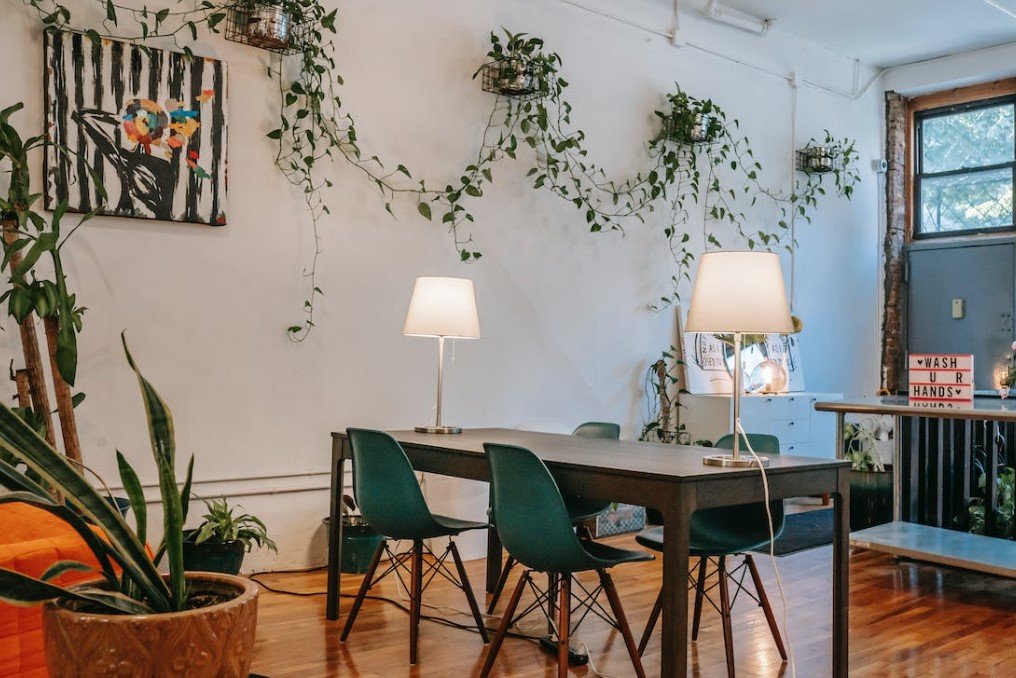Transforming the look and feel of your home can be a challenging and exciting task. One of the best ways to add a touch of elegance and sophistication to your living space is by creating a visually stunning interior design. However, achieving a breathtaking interior design often requires an attentive approach to every aspect of your home’s makeover, starting with the right house interior painting.
Undoubtedly, painting is one of the most effective ways to give your home an instant facelift. Not only does it add a fresh new look to your walls, but it can also help cover up unsightly marks and blemishes that might be hiding beneath. Interior painting plays a crucial role in enhancing your home’s aesthetic appeal and uplifting the overall mood and atmosphere in your living space. With the right color selection and painting techniques, you can create a home that perfectly reflects your unique personality and lifestyle.

In this article, we’ll explore how house interior painting can be a game-changer for your home renovation. We’ll delve into some essential tips and tricks for selecting the right colors, textures, and finishes that will transform your living space into a magnificent work of art. Whether you’re planning to upgrade your entire home or just a single room, this guide will help you unlock the full potential of your interior design. Get ready to discover how you can create a stunning ambiance with the power of paint!
Visualize your painting project:
A. Analyze your current interior:
The first step in visualizing your painting project is to analyze your current interior. This means taking a close look at the walls, floors, furniture, and decor of your home. Consider the existing colors, textures, and patterns, and also take note of any architectural elements, such as moldings or trim. Determine what you like about your current interior and what you’d like to change. This information will help you make decisions about color and other design elements later on.
B. Envision the color scheme:
Once you have a good understanding of your current interior, it’s time to envision the color scheme for your new interior painting project. Begin by thinking about what colors you like and what mood you want to create in each room. Color psychology can play a big role in creating the right atmosphere, so consider the effect that different shades can have on mood and energy levels. Take into account the natural light in each room and how the colors will look in different lighting conditions.
C. How to create a mood with texture and other painting techniques:
In addition to color, other painting techniques like texture can also affect the mood and ambiance of a room. For instance, a glossy finish can create a modern, elegant look, while a matte finish can create a more subdued, rustic feel. Patterns, such as stripes or stenciling, can also be used to add interest and depth to a room. Textured wallpaper or a faux finish can provide a unique and creative touch to a room.
Accent Walls: A Style Statement
A. Explanation of Accent Walls:
An accent wall is a wall that is painted or decorated differently from the rest of the walls in a room. It is designed to draw attention and create visual interest. Accent walls are a popular trend in interior painting and are an excellent way to add character, depth, and personality to a space. Typically, accent walls are painted a different color than the other walls or feature an eye-catching pattern or textured finish.
B. Discussion of Different Kinds of Accent Walls:
There are various kinds of accent walls that you can choose from when transforming your home’s interior. Some of the popular types of accent walls include
1. Painted Accent Wall: This is the most common type of accent wall. It involves painting one wall in a different color than the other walls in the room. You can use a bold color that contrasts with the rest of the walls or goes for a more subtle approach by choosing a shade that is slightly lighter or darker than the other walls.
2. Textured Accent Wall: This kind of accent wall is perfect for adding depth and visual interest to your room. You can achieve this by adding textured wallpaper or using different techniques such as stenciling or rag-rolling to give the wall a unique texture.
3. Wallpapered Accent Wall: A wallpapered accent wall is a great way to create a unique and eye-catching feature wall. You can choose from various designs, colors, and patterns to match your preferences and style. Using wallpaper can add a focal point to a room, brighten up a space, or create a cozy feeling.
4. Stone or Brick Accent Wall: A stone or brick accent wall is a popular trend in modern interiors. It adds character and texture to a room and creates an industrial or rustic feel. You can achieve this by using stone or brick veneers, which are lightweight and easy to install.
C. How to Choose the Right Wall for an Accent:
Choosing the right wall for an accent is crucial in achieving the desired effect. Here are some tips to help you choose the right wall:
1. Choose the wall that stands out the most: Choose a wall that naturally draws your eye to it. This can be a wall that is direct across from the doorway, one with a unique feature like a fireplace or a built-in shelf, or one that receives a lot of natural light.
2. Consider the room’s purpose: Consider the room’s function and choose an accent wall that complements it. For instance, if you’re painting the living room, consider using a warm, inviting color that promotes relaxation and socializing.
3. Think about the color palette: When picking your accent wall color, it should complement the other colors in the room. Use a color wheel to ensure that the color you choose matches well with the existing color scheme.
Choosing The Right Color Scheme
Choosing the right color scheme can be a daunting task, but it is a crucial aspect of home interior painting. The perfect color scheme can transform the look and feel of a home, making it more inviting and attractive. Here are some factors to consider when choosing the right color scheme for your home.
A. How to choose the perfect color scheme
Before embarking on any painting project, it is essential to identify the color scheme that best complements your home’s style and personality. One way to do this is by taking inspiration from existing colors in your home, such as furniture, artwork, and decorative items, and selecting shades that complement them.
It is also important to consider the purpose and use of the space. For instance, a bedroom may require calming and relaxing tones like blue or green, while a dining room may need a more vibrant and stimulating hue like red or orange.
Another aspect to consider is the natural light that enters your space. Natural light can affect how colors look in your home. The amount and direction of light determine how bright or dark color may appear, so it’s important to test paint samples before making a decision.
B. Significance of color psychology on mood and vibe
Colors have a significant impact on our moods and emotions, and this is why choosing the right color scheme is essential. For example, blue, green, and lavender tones are known to have a calming effect, while yellow and orange hues tend to be more energetic.
The psychology of color is a crucial element in determining the overall mood and vibe of a space. This is particularly crucial for spaces like the living room, where people gather to socialize and relax, or the bedroom, where individuals seek respite and relaxation.
C. Tips on selecting the right color scheme for different spaces
Different spaces in your home call for different color schemes and tones. Here are some tips on selecting the right color scheme for different spaces: – Living room: This is a high-traffic area and serves as a gathering space for socializing and entertainment. Neutral tones like beige, grey, and white, provide a clean backdrop and make it easier to add pops of color through accessories like throw pillows and rugs. Warm tones like red and orange can create a cozy and inviting atmosphere.
1. Bedroom: Bedrooms are meant to be a peaceful haven for relaxation. Cool-toned colors like blue, lavender, and green, create a soothing environment and promote relaxation.
2. Kitchen: Kitchens are often the hub of the home, and as such, require a bright and inviting color scheme. Light tones like white, beige, or pale yellow provide a fresh and clean backdrop, while bright hues like red, green, and blue can add a pop of color to the space.
Painting Techniques To Create Texture
A. Explanation of different texture creation techniques:
Textured painting techniques can add depth and dimension to a simple wall or ceiling. There are various ways to create a textured surface, such as using sponges, rags, brushes, rollers, and even everyday items like bubble wrap or plastic bags. Some common techniques include:
- Sponging: This technique involves dipping a sponge in paint and then dabbing it onto the wall to create a bumpy, irregular surface. Sponging can create different effects depending on the type of sponge, the amount of paint, and the pressure applied.
2. Ragging: This technique involves crumpling a rag and then rolling or dragging it across a freshly painted surface. Ragging can create a subtle texture with a soft, mottled effect.
3. Stippling: This technique involves using a brush to apply paint in dots or small strokes, creating a stippled effect. Stippling can create a slightly raised texture that resembles stucco or plaster.
4. Strie: This technique involves dragging a brush or roller in long, vertical strokes, creating a striped effect. Strie can create a formal, elegant look with a subtle texture.
5. Comb: This technique involves using a comb-like tool to comb through wet paint, creating a ridged or grooved texture. Combing can create a linear, geometric effect.
B. How to create a textured accent wall:
Creating a textured accent wall can be a great way to add interest and focal point to a room. Here’s how to do it:
1. Choose a wall: Decide which wall you want to make as your accent wall. Typically, the wall behind the headboard, sofa, or fireplace mantel is a good choice.
2. Prep the wall: Clean the wall and repair any cracks or holes. Apply a primer to the wall to ensure that the paint adheres properly.
3. Choose your technique: Select the textured painting technique you want to use. Sponging or ragging are popular choices for accent walls because they create a subtle texture that complements other walls.
4. Apply the base coat: Apply a base coat of paint in your desired color to the accent wall. Use a roller to cover the entire wall evenly.
5. Apply the textured paint: Once the base coat is dry, apply the textured paint using your chosen technique. Work in small sections and blend the paint as you go to create a seamless texture.
6. Experiment with colors: Consider using different shades of the same color for a monochromatic look, or contrasting colors for a bold statement.
C. Maximum impact with minimal texture:
You don’t have to create a heavily textured surface to make an impact. Sometimes, a subtle texture can be just as effective. Here are some tips for creating minimal but impactful texture:
- Use a dry brush technique: Dip a dry brush into the paint and then dab it onto a wall in a random, haphazard pattern. This creates a slightly raised, weathered effect that adds interest without being too overwhelming.
2. Texturize with wallpaper: Use patterned wallpaper with a subtle texture, such as grasscloth or linen, for a sophisticated look.
3. Emphasize architectural details: Use paint to highlight architectural features like trim, moldings, or wainscoting. This can create a subtle but effective texture that adds depth and dimension to a room.
Budget-Friendly Renovations
A. Importance of budget-friendly choices
When planning to renovate your home, it is important to prioritize budget-friendly choices. This helps to avoid overspending on unnecessary expenses and also ensures that your renovation project is within your budget. By creating a budget, you can make wise decisions and allocate enough funds for essential expenses such as materials, labor, and other necessary costs.
B. How to save on painting costs
One of the most effective ways to save on painting costs is to do the prep work yourself. This includes cleaning, sanding, and priming the surfaces that need painting. Hiring a professional painter can also help ensure that the job is done efficiently and effectively. Furthermore, buying paint in bulk and taking advantage of special deals and discounts can also save you money.
C. Discussion of efficient paint products
Investing in quality paint products can be a wise decision in the long term. Efficient paint products last longer, require fewer coats, and produce better results, which ultimately saves you time and money. Eco-friendly and low-VOC (volatile organic compounds) paint options are also available, which are better for your health and the environment.
Inspiration and Personalization
A. Design choices inspired by personal interests
When designing your home interior, you should keep your personal interests and preferences in mind. This helps to create a space that reflects your personality and style. For example, if you are an art enthusiast, you can choose to display art pieces that you love or create an accent wall inspired by a favorite painting.
B. How to personalize your space with wall art
Adding wall art to your home is a great way to add unique character and warmth to your space. You can choose to showcase pictures, posters, paintings, or even sculptures that resonate with your personality and complements your decor. Wall art can be hung in any room and is an affordable way to spruce up any space.
C. Adding meaningful items and design elements
Personalizing your home doesn’t just stop with wall art. Adding meaningful objects like family heirlooms, souvenirs from travels, or even DIY pieces can create a space that is uniquely yours. Incorporating elements like plants, textiles, and decor can also help to bring life and warmth into your home. It’s essential to strike a balance between practicality and personal style to create an inviting and comfortable environment that inspires and rejuvenates you.
Achieve Harmony:
A. The relevance of consistency in painting:
Consistency in painting refers to the use of a similar color scheme or style throughout the house. This helps to create a cohesive look and feel that connects the different rooms of the house. Consistency in painting can help to create a sense of uniformity and sophistication in the home.
B. How to achieve a sense of harmony with the color scheme and décor:
To achieve harmony in painting, it is important to select colors that complement each other and the overall décor of the house. The use of complementary colors, such as blue and orange or green and red, can create a sense of balance and harmony. Additionally, it is important to use color in strategic ways, such as accent walls or statement pieces, to create interest and depth in the room.
C. Creating flow in style and color:
Creating flow in style and color involves using similar textures, patterns, and design elements throughout the house. This creates a sense of continuity and flow that connects each room to the next. By using similar colors, patterns, and styles, you can create a cohesive and inviting home.
Creating a Transformative Impact:
A. Importance of transformative impact:
Transformative impact refers to the ability of interior painting to completely change the look and feel of a home. By employing the right color schemes and painting techniques, you can create a space that feels brand new. The transformative impact is important because it can help homeowners fall in love with their homes again, increasing their enjoyment and overall quality of life.
B. How painting can transform homes:
Painting can transform homes by changing the colors and textures of the walls. Fresh coats of paint can provide a clean, updated look, while bold color choices can create excitement and interest. Additionally, painting gives homeowners the opportunity to express their style and personality throughout their homes.
C. Analysis of the massive difference interior painting can make:
The difference that interior painting can make is massive. By transforming the colors and textures of the walls, you can create a completely new space that feels fresh and exciting. Additionally, painting can add value to your home, as it is a simple and cost-effective way to update and modernize the space. Overall, interior painting is a powerful tool that homeowners can use to transform their homes and create spaces that they love.
Conclusion
Thus, this article has highlighted how house interior painting can significantly transform your home’s aesthetic appeal and create a cozy and inviting environment. We have explored the various benefits of interior painting, including the ability to increase the value of your property and inject your personality and style into your living space. From choosing the right color scheme and paint type to seeking professional help, these tips will help you achieve a stunning house interior painting.
Interior painting is a simple and effective way to refresh your home and transform its look without breaking the bank or undergoing a major renovation. With the knowledge and resources provided in this article, homeowners can confidently take the next step towards enhancing their house interior. So, don’t hesitate to start your journey today and enjoy a beautiful and welcoming home that reflects your unique style and personality.
FAQs – House Interior Painting
1. Why should I consider house interior painting?
A: House interior painting can transform the look and feel of your home, adding vibrancy and personality to each room. It is also an affordable way to update your space without undertaking major renovations.
2. How do I choose the right colors for my home?
A: Choose colors that complement your furnishings and decor, as well as colors that reflect your personality and style. It can be helpful to gather inspiration from magazines or work with a professional interior designer.
3. Can I paint over the wallpaper?
A: Yes, it is possible to paint over wallpaper, but it will require some preparation. The wallpaper will need to be cleaned, smoothed, and primed before being painted.
4. Can I paint my popcorn ceiling?
A: Yes, it is possible to paint popcorn ceilings, but it may require some additional preparation. Be sure to consult with a professional painter who can properly prep the surface and safely handle the textured material.
5. How long does it take to complete an interior painting project?
A: The length of time it takes to complete an interior painting project varies depending on the size and complexity of the project. A small project, such as a single room, may take a few days, while a larger project, such as an entire home, may take several weeks.














